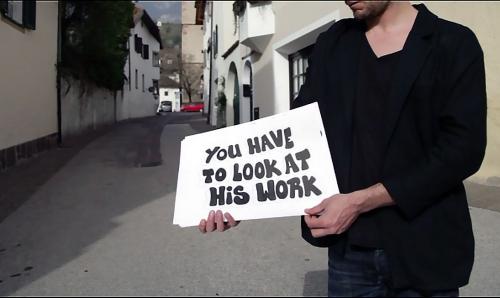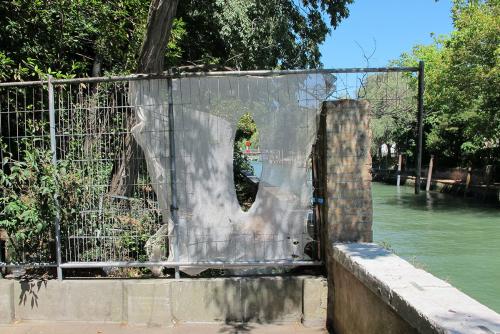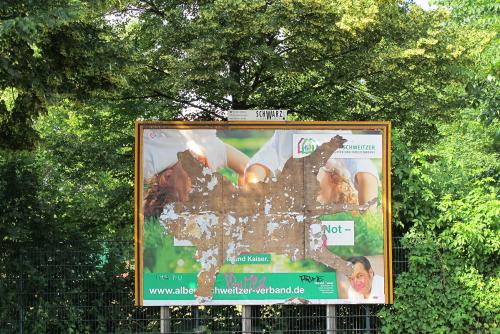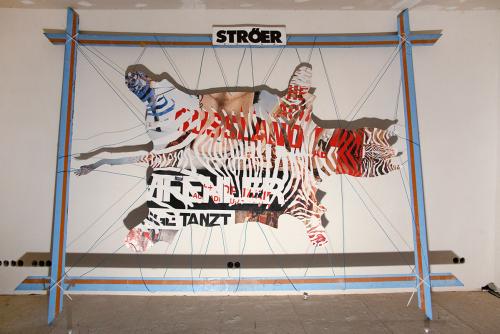The Wa

1/8
Art Residency Homesick Blues, 2016, Eppan Collection of quote collected during different art residencies Camera : Sarah Oberrauch Music : Yan Legay Editing: Rika Otsuka

2/8
Concetto spaziale, 2013, Venezia, Italy A hole cut into a fence preventing access to the Venice Biennale. Lucio Fontana stated that by progressing beyond minimalism and into subtraction via the cutting of his canvases, one can give the world a way to enter art.

3/8
Correction, 2012, Marseille, France Graffiti on the streets of Marseille are corrected for spelling, grammar and punctuation and graded using red spray paint and pen.

4/8
Safari in the urban jungle, 2013, Düsseldorf, Berlin, Germany, with Fra Biancoshock & Oakoak In collaboration with Fra Biancoshock & Oakoak , offering interpretations of the theme "The Urban Jungle" separately during one month and publishing their works simultaneously.

5/8
Safari in the urban jungle, 2013, Düsseldorf, Berlin, Germany, with Fra Biancoshock & Oakoak In collaboration with Fra Biancoshock & Oakoak , offering interpretations of the theme "The Urban Jungle" separately during one month and publishing their works simultaneously.

6/8
Nest, 2013, Vienna Spikes designed to keep birds from landing and roosting on man-made structures are collected from signage and cctv cameras and converted into a sculpture.
The Wa’s public interventions and sculptures are obstacles which could be rephrased with the terms “Urban Hacking” or “Artivism”. Unmistakably, his artistic practice is linked to european avantgarde movements such as Situationism, Dada of Fluxus. The often comical, always poignant works stir up the observer and ideally succeed in generating skepticism towards society’s control and surveillance mechanisms. Historical strategies of appropriation such as the Situationists’ “dérive” are reflected on and revisited in the light of current aesthetic manifestations and practices.
Two seconds after I had finished the call with The Wa, I realized that I had forgotten to ask him about the mean- ing of his artistic name. I wanted to call him back immediately, but then I remembered that a couple of minutes earlier he had told me that he never signs his works. “The fact that they’re unsigned helps people not to look at the name but at the piece”, which he thinks “is made 50% by me and 50% by the viewer”. So eventually I decided that the interpretation of his name was up to me (and up to you too), and so would be the interpretation of his artistic practice.
As I wrote presviously, The Wa never puts his name on his urban art interventions. Moreover, he never uses captions, nor does he write statements or press releases (even because then it’d be very easy to nd him). This attitude might seem, for those who are familiar with the contemporary art scene, quite weird. What we are used to seeing in museums, galleries and fairs is a formal and institutional apparatus where the captions are, in a way, more important than the artworks. If you think about it, what gives, generally speaking, the monetary value and the prestigiousness to an artwork is: the artist’s name, the year of production, measures, technique and, in some cases, the edition number. All things that you can find in a caption. Then if you are an artist, you make art and you want to show it then you (and curators, galleries, foundations, muse- ums, cultural associations along with you) necessarily have to communicate it. Therefore you make invitation cards and flyers, write press releases and critical texts, publish catalogs, pay for adverts and upload images on social networks.
The Wa does none of these things for his public interventions. His works appear without sign and notice, and after a while (it could be hours, days or months) they disappear (they are taken by pedestrians viewers, knocked down by property owners or public administration workers, or for their natural ephemerality), eventually they only exist on his website. So, since the majority of his works are visible only in a digital format, please go and take a look at his website the-wabsite.com and make your own impression (as he says: the other 50% of his work is completed by the viewer). I did my considerations (and I was asked to report them in these lines) and without taking too long, I can sum them up in a single word: anomaly.
Anomaly (noun anom·a·ly ə-’nä-mə-lē):
1. an act or instance of not following the general rule or method;
2. something anomalous: something different, abnormal, strange, or not easily described.
The Wa’s works are anomalous because they appear in uncommon places with uncommon shapes. Sometimes they are mimetic with the urban background, and I guess only people walking on the street not looking at their smartphone can see them and get intrigued; sometimes they are so massive that even sleep-walkers would notice them. Sometimes they are very serious, sometimes they are funny, sometimes they can seem not very accurate but they always have a thoughtful lightheartedness that makes it possible for him to reflect on political or social issues in many different parts of the globe (Sri Lanka, Switzerland, Morocco, Russia, China, Italy, Germany, France, Poland) with a non-demagogical glance (when I asked him what the aim of his art was, he replied: “I think about what’s the point only when I’m deeply depressed” and then he added “but I distrust those who want to change the world”).
What also makes his works anomalous it that, in a world where the diffidence towards differences is growing, they represent a hymn to curiosity, active action and freedom of thought.
This is the reason why I won’t finish with a de nite and definitive opinion but leave it open to you, so please feel free to express your comments. Maybe find the space below.
The Wa's Interventionen und Skulpturen im öffentlichen Raum sind Stolpersteine, die mit den Begriffen "urban hacking" oder "artivism" umschrieben werden können. Unverkennbar knüpft seine künstlerische Praxis an die europäischen Avantgardebewegungen wie Situationismus, Dada und Fluxus an. Die sehr oft komischen, immer pointierten Arbeiten rütteln die Betrachter und Betrachterinnen auf und erzeugen im besten Falle eine skeptische Haltung gegenüber gesellschaftlichen Kontroll- und Überwachungsmechanismen.
Für seine Skulptur hat the Wa Taubenspikes (auch Vogelabwehrspitzen genannt) entwendet, um daraus ein "Nest" zusammenzusetzen und damit die eigentliche Funktion des Materials auf symbolische Weise zu verkehren. http://www.the-wabsite.com/
The Wa realizza sculture e interventi nello spazio pubblico che si configurano come pietre d’inciampo che possono essere riletti alla luce dei termini „Urban Hacking“ o „Artivism“. Il riferimento alla pratica artistica dei movimenti di avanguardia europei quali Situazionismo, Dada e Fluxus è d’obbligo. Le sue opere, spesso ilari ed ironiche, scuotono osservatori - osservatrici e evocano in loro dubbi, scetticismo a ruguardo dei meccanismi di controllo e di sorveglianza. A tale proposito The Wa riprende occasionalmente strategie storica- mente già sedimentate quali il „dérive“ dei Situazionisti per metterle a confronto con tecniche ed estetiche contemporanea.
Due secondi dopo aver chiuso la chiamata con The Wa mi sono reso conto che avevo scordato di chiedergli il signicato del suo nome. Ho pensato di richiamarlo subito ma poi mi sono ricordato che pochi minuti prima mi aveva detto che non firma mai i suoi lavori, “il che aiuta a focalizzarsi non sul nome ma sull’opera che è fatta al 50% da me e per il restante 50% da chi la osserva”. Così ho lasciato perdere e ho deciso che stava a me (e a voi che leggete) interpretare tanto il significato del suo nome quanto quello del suo lavoro.
Come scritto poche linee sopra, The Wa non firma i propri interventi di arte urbana, ma non solo, non usa mai didascalie, non scrive testi né comunicati stampa (anche perché tutto ciò aiuterebbe a rintracciarlo). Questa attitudine, per chi lavora o frequenta musei, mostre, ere e gallerie di arte contemporanea, può sembrare strana. In questi luoghi istituzionali siamo abituati a confrontarci con un modello formale dove le didascalie sono, in un certo modo, quasi più importanti dei lavori stessi. Se ci pensate, il valore economico e l’aura di prestigio di un’opera è dato dal nome dell’artista, dall’anno di produzione, il numero di edizione (se si stratta di un multiplo), le dimensioni e la tecnica del lavoro esposto. Informazioni che sono proprio quelle che trovate su ogni didascalia. Se poi un artista vuole esporre la propria arte allora deve (e con lui la galleria, il museo, la fondazione, i curatori, l’associazione culturale che lo supportano) entrare in contatto con il pubblico generico e degli addetti ai lavori attraverso inviti, flyer, comunicati stampa, testi critici, pubblicità, social network e via così.
Per i suoi lavori pubblici The Wa non fa nulla di tutto ciò. I suoi lavori appaiono senza firma e senza preavviso, dopo un po’ (ore, giorni o mesi) essi scompaiono (presi dai passanti-spettatori, rimossi dai proprietari degli edifici, dalle forze dell’ordine, da lavoratori delle amministrazioni comunali o svaniti per la natura effimera dei lavori stessi). Una volta spariti li trovate solo sul suo sito web. Visto, quindi, che la maggior parte dei lavori di The Wa esistono ormai solo nella loro documentazione digitale vi rimando proprio al sito the-wabsite.com Trascorreteci un po’ di tempo e fatevi una vostra opinione (dopo tutto è stato lui stesso a dire che il 50% del proprio lavoro è nelle mani di chi lo osserva). Io ho fatto le mie considerazioni (motivo per cui mi è stato chiesto di scrivere queste righe) e, senza prolungarmi molto, ve le espongo condensate in una sola parola: anomalia.
Anomalia (a-no-ma-lì-a, n.f.)
1 deviazio- ne dalla norma; irregolarità, eccezione
2 qualcosa di anomalo: qualcosa di di- verso, anormale, strano o difficilmente descrivibile.
Il lavori di The Wa sono anomali perché appaiono in luoghi, modi e forme non convenzionali. A volte si mimetizzano con il tessuto urbano rendendosi visibili solo agli occhi di chi cammina con lo sguardo rivolto non solo allo schermo del proprio smart phone, altre volte sono talmente grandi che anche un sonnambulo li noterebbe. A volte sono seri, altre divertenti, altre ancora non del tutto accurati, ma in tutti c’è una sorta di leggerezza riflessiva che gli permette di affrontare temi politici e sociali in tante zone diverse del mondo (dallo Sri Lanka alla Russia, dalla Svizzera al Marocco, dall’Italia alla Cina) senza mai cadere nella demagogia (quando gli ho chiesto quale fosse lo scopo della sua arte lui mi ha riposto “Mi chiedo lo scopo solo quando sono profondamente depresso” e poi ha aggiunto “Ho paura di chi vuole cambiare il mondo”).
Ma soprattutto i lavori di The Wa sono anomali perché, in un mondo sempre meno aperto alle diversità, rappresentano un inno alla curiosità, alla libera azione e al libero pensiero. Proprio per questo più che darvi una mia opinione finale e definitiva preferisco lasciare a voi la libertà di esprimere le vostre considerazioni. Magari proprio qui sotto.

1/8
Art Residency Homesick Blues, 2016, Eppan Collection of quote collected during different art residencies Camera : Sarah Oberrauch Music : Yan Legay Editing: Rika Otsuka

2/8
Concetto spaziale, 2013, Venezia, Italy A hole cut into a fence preventing access to the Venice Biennale. Lucio Fontana stated that by progressing beyond minimalism and into subtraction via the cutting of his canvases, one can give the world a way to enter art.

3/8
Correction, 2012, Marseille, France Graffiti on the streets of Marseille are corrected for spelling, grammar and punctuation and graded using red spray paint and pen.

4/8
Safari in the urban jungle, 2013, Düsseldorf, Berlin, Germany, with Fra Biancoshock & Oakoak In collaboration with Fra Biancoshock & Oakoak , offering interpretations of the theme "The Urban Jungle" separately during one month and publishing their works simultaneously.

5/8
Safari in the urban jungle, 2013, Düsseldorf, Berlin, Germany, with Fra Biancoshock & Oakoak In collaboration with Fra Biancoshock & Oakoak , offering interpretations of the theme "The Urban Jungle" separately during one month and publishing their works simultaneously.

6/8
Nest, 2013, Vienna Spikes designed to keep birds from landing and roosting on man-made structures are collected from signage and cctv cameras and converted into a sculpture.

